| Start of section
Production, amateur Radio amateurs Aircraft model, rocket-model Useful, entertaining |
Stealth Master
Electronics Physics Technologies Inventions |
Secrets of the cosmos
Secrets of the Earth Secrets of the Ocean Tricks Map of section |
|
| Use of the site materials is allowed subject to the link (for websites - hyperlinks) | |||
Navigation: => |
Home / Patent catalog / Catalog section / Back / |
|
INVENTION
Patent of the Russian Federation RU2145165
![]()
STIMULATOR OF PLANT GROWTH
The name of the inventor: Shin-iti Hirakawa (JP); Yasuo Camuro (JP); Suguru Takatsuto (JP); Tsuyoshi Watanabe (JP); Hiroki Kuriyama (JP)
The name of the patentee: Nippon Seon Co., Ltd. (JP); Tama Biochemical Co., Ltd. (JP)
Address for correspondence: 129010, Moscow, ul.Bolshaya Spasskaya, 25, p. 3, LLC "Gorodissky and Partners"
Date of commencement of the patent: 1995.08.25
A new plant growth stimulant is described which contains as active ingredients (i) jasmonic acid or jasmonate of general formula (1), wherein R 1 is a pentyl or pentenyl group and R 2 is hydrogen or an alkyl group, and (ii) a brassinosteroid represented by Formula (2), and a liquid carrier, wherein the weight ratio of the brassinosteroid of formula (2) to jasmonic acid or jasmonate of formula (1), i.e. (I)  Ii) is in the range 1: 1 to 1: 5000, and the content of components (i)
Ii) is in the range 1: 1 to 1: 5000, and the content of components (i)  Ii) 0.01 to 500 ppm. And from 0.001 to 1 ppm. Respectively, based on the total weight of the stimulant composition. The technical result is the creation of a plant growth stimulant composition that has a promoting effect on the growth of root crops, potatoes and taro, cereals, fruit and vegetable crops, legumes, leafy vegetables, fruit trees, tree plants, flowering plants and industrial crops.
Ii) 0.01 to 500 ppm. And from 0.001 to 1 ppm. Respectively, based on the total weight of the stimulant composition. The technical result is the creation of a plant growth stimulant composition that has a promoting effect on the growth of root crops, potatoes and taro, cereals, fruit and vegetable crops, legumes, leafy vegetables, fruit trees, tree plants, flowering plants and industrial crops.
DESCRIPTION OF THE INVENTION
This invention relates to a plant growth stimulant. More specifically, it relates to a plant growth stimulant composition that has a promoting effect on the growth of root crops, potatoes and taro, cereals, fruit and vegetable crops, legumes, leafy vegetables, fruit trees, tree plants, flowering plants and industrial crops.
Until now, in the field of agricultural methods, there was a big problem, which was to stimulate (promote) normal growth of crops and increase agricultural productivity. It is expected that in the future there will be a shortage of food in many countries of the world, and the above problem becomes more important than ever. To solve this problem, many methods for regulating temperature and light irradiation in agricultural structures were suggested, but for this purpose special equipment or devices and the effects of stimulating growth and increasing productivity are not proportional to the labor expended.
In recent years, studies have been conducted on the effect of physiologically active substances isolated from plant tissues, which have an effect on the life of plants in the environment, that is, germination, growth, flowering, fruiting and aging, in order to stimulate growth and increase productivity. However, up to now only a limited number of physiologically active substances have been introduced into practical use, showing the ability to stimulate plant growth, and only a few active substances are suitable for use under existing conditions to stimulate growth when growing plants in the fields.
The main object of the present invention is to provide a plant growth stimulator exhibiting increased activity against plants.
After carrying out the full study, the applicants have found that the combination of jasmonic acid or jasmonate with a certain brassinosteroid compound shows increased activity with regard to plant growth stimulation, and thus the present invention has been completed.
According to the present invention, there is provided a plant growth stimulant comprising, as active ingredients (i) jasmonic acid or jasmonate represented by the following formula (1): 
Wherein R 1 is a pentyl or pentenyl group, and R 2 is hydrogen or an alkyl group, and (ii) a brassinosteroid represented by the following formula (2): 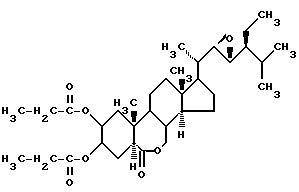
And a liquid carrier wherein the weight ratio of the brassinosteroid of formula (2) to jasmonic acid or jasmonate of formula (1), (i): (ii) is in the range of 1/1 to 1/5000, and the content of components (i): (ii ) Is from 0.01 to 500 ppm. And from 0.001 to 1 ppm. Respectively, based on the total weight of the stimulant composition.
Preferred is a plant growth promoter, wherein R 1 in formula (1) is a pentyl group or a 2-pentyl group, and where
R 2 in formula (1) is an alkyl group having from 1 to 10 carbon atoms, and wherein
The jasmonate of formula (1) is n-propyl dihydrojasmonate.
PREFERRED EMBODIMENT OF THE INVENTION
R 1 in formula (1) is a pentyl group or a pentenyl group. As the pentenyl group, a 2-pentenyl group is preferred. R 2 represents a hydrogen atom or an alkyl group, preferably an alkyl group. The number of carbon atoms in the alkyl group is usually in the range of 1 to 10, preferably 2 to 6, more preferably 3 or 4. As specific examples of the alkyl group, mention may be made of methyl, ethyl, n-propyl, isopropyl, n- Isobutyl, sec-butyl, t-butyl, n-pentyl, isopentyl, 2-methylbutyl, 1-methylbutyl, n-hexyl, isohexyl, 3-methylpentyl, 2-methylpentyl, 1-methylpentyl, n-heptyl, isoheptyl, n- Octyl, isooctyl, 2-ethylhexyl, nonyl and decyl groups.
Jasmonic acid and jasmonate can be obtained by conventional methods. For example, a dihydrojasmonate which has a pentyl group as R 1 in formula (1) and an alkyl group having 1-10 carbon atoms as R 2 in formula (1) can be prepared by reacting 2-pentylcyclopenten-1-one with alkyl malonate By the addition of Michael and then decarboxylating the resulting reaction product.
The brassinosteroid of formula (2) is a known compound, it can be prepared by conventional methods. For example, a method can be used where (22E, 24S) -24S-ethyl-5 ![]() - cholesta-2,22-dien-6-one is mixed with N-methylmorpholine-N-oxide and acetone; A catalytic amount of osmium tetroxide is added to the mixture, whereby the first compound is oxidized to form 2
- cholesta-2,22-dien-6-one is mixed with N-methylmorpholine-N-oxide and acetone; A catalytic amount of osmium tetroxide is added to the mixture, whereby the first compound is oxidized to form 2 ![]() , 3
, 3 ![]() - dihydroxy-24S-ethyl-5
- dihydroxy-24S-ethyl-5 ![]() - cholest-22-en-6-one; The compound thus obtained is reacted with propionic anhydride or propionyl chloride to give 2
- cholest-22-en-6-one; The compound thus obtained is reacted with propionic anhydride or propionyl chloride to give 2 ![]() , 3
, 3 ![]() - dipropionyloxy-24S-ethyl-5
- dipropionyloxy-24S-ethyl-5 ![]() - cholest-22-en-6-one; And then the thus obtained compound is reacted with an organic peracid, for example m-chloroperbenzoic acid, to give (22R, 23R, -24S) -2
- cholest-22-en-6-one; And then the thus obtained compound is reacted with an organic peracid, for example m-chloroperbenzoic acid, to give (22R, 23R, -24S) -2 ![]() , 3
, 3 ![]() - dipropionyloxy-22,23-epoxy-B-homo-7-oxa-5
- dipropionyloxy-22,23-epoxy-B-homo-7-oxa-5 ![]() - stigmastan-6-on.
- stigmastan-6-on.
The ratio of jasmonic acid or jasmonate of formula (1) to the brassinosteroid of formula (2) in the plant growth promoter of the present invention is not particularly limited and may vary depending on certain crops, the intended purpose and the stage of development thereof. However, the ratio of brassinosteroid to jasmonic acid or jasmonate is usually in the range of 1 / 0.1 to 1/1000000, preferably from 1/1 to 1/100000, and more preferably from 1/10 to 1/10000.
The plant growth promoter of the present invention can be used as such or as a mixture with a carrier, or, if desired, also with other additives. The form of the drug is not particularly limited, it can be in the conventional form. For example, the active ingredients can be used in the form of emulsions, suspensions, powders, hydrates, aqueous solutions, granules, pastes and aerosols.
If desired, the plant growth promoter of the present invention can be incorporated into conventional additives, for example, a carrier, an emulsifier, a dispersant, a distributing agent, a wetting agent, a fixative and a disintegrator.
The carrier is solid carriers and liquid carriers. Preferred solid carriers include inorganic materials such as talc, bentonite, clay, kaolin, diatomaceous earth, white carbon, silicic anhydride, synthetic calcium carbonate, vermiculite, silica sand, mica, pumice, gypsum, calcium carbonate, dolomite , Magnesia, calcium hydroxide, phosphoric lime, zeolite and ammonium sulfate; Organic plant based materials, for example soybean flour, tobacco powder, walnut powder, wheat flour, wood flour, starch and crystalline cellulose; Synthetic high polymer substances and natural high-molecular substances, for example coumarone resin, coumarone-indene resin, alkyd resin, polyvinyl chloride, polyalkylene glycol, ketone resin, esterified rosin, copal, dammarovoy resin; Waxes, for example carnauba wax and beeswax; And urea. Preferably used liquid carriers include paraffinic and naphthenic hydrocarbons, for example kerosene, mineral oil, spindle oil and petroleum jelly; Aromatic hydrocarbons, for example benzene, toluene, xylene, ethylbenzene, cumene and methylnaphthalene; Chlorohydrocarbons, for example carbon tetrachloride, chloroform, trichlorethylene, monochloroethylene and o-chlorotoluene; Ethers, for example dioxane and tetrahydrofuran; Ketones, for example acetone, methyl ethyl ketone, diisobutyl ketone, cyclohexanone, acetophenone and isophorone; Esters, for example, ethyl acetate, amyl acetate, ethylene glycol acetate, diethylene glycol acetate, dibutyl maleate and diethyl succinate; Alcohols, for example methanol, ethanol, isopropanol, butanol, n-hexanol, ethylene glycol, propylene glycol and diethylene glycol; Ether alcohols, for example, ethylene glycol phenyl ether and diethylene glycol butyl ether; And polar solvents, for example dimethylformamide and dimethylsulfoxide; And water.
As an emulsifier and a dispersant, surfactants are commonly used, which include non-ionic, cationic, anionic and ampholytic surfactants. In general, a non-ionic surfactant and / or anionic surfactant is preferably used. As characteristic examples of the non-ionic surfactant, mention may be made of products obtained by polymerization and addition of ethylene oxide to higher alcohols, for example lauryl alcohol, stearyl alcohol and oleyl alcohol; Products obtained by polymerization and addition of ethylene oxide to alkylphenols, for example isooctylphenol and nonylphenol; Products obtained by polymerization and addition of ethylene oxide to alkylnaphthols, for example, butylnaphthol and octylnaphthol; Products obtained by polymerization and addition of ethylene oxide to higher fatty acids, for example palmitic acid, stearic acid and oleic acid; Products obtained by polymerization and addition of ethylene oxide to monoalkyl or dialkyl phosphates, for example stearyl phosphate and dilauryl phosphate, products obtained by polymerization and addition of ethylene oxide to amines, for example dodecylamine and stearic acid amide; Esters of higher fatty acids and polyhydric alcohol, for example sorbitan (anhydrosorbitol), and products obtained by polymerization and addition of ethylene oxide to higher esters; Products obtained by polymerization by the addition of ethylene oxide with propylene oxide; And esters of polybasic acid with an alcohol, for example dioctyl succinate. As characteristic examples of anionic surfactants, mention may be made of alkyl sulfate salts, for example sodium lauryl sulfate and salts of oleyl sulfate with amines; Alkyl sulfonate salts, for example the sodium salt of dioctyl sulfosuccinate and sodium 2-ethylhexylsulfonate; Arylsulfonate salts, for example sodium isopropylnaphthalenesulfonate, sodium methylenebisnaphthalenesulfonate, sodium lignin sulfonate and sodium dodecylbenzenesulfonate; And phosphate salts, for example sodium tripolyphosphate.
The content of jasmonic acid or jasmonate and brassinosteroid in the plant growth stimulator of the present invention may vary depending on the particular plant species, the form of the stimulant preparation, the method of application thereof, and the stage of plant development. When the plant growth stimulant is used in combination with a liquid carrier, i.e. in the form of a solution, emulsion or suspension or other liquid preparation, the content of jasmonic acid or jasmonate in the liquid preparation is generally in the range of 0.01 to 500 ppm, preferably From 0.05 to 300 ppm, more preferably from 0.1 to 200 ppm. (W / v) and the brassinosteroid content in the liquid preparation is generally in the range of 0.000001 to 0.1 ppm, more preferably 0.001 to 0.01 ppm. (W / v). When the content of the respective ingredients is within the ranges mentioned, the effect of plant growth stimulation is actively manifested.
When the plant growth stimulant is used in combination with a solid carrier, the content of jasmonic acid or jasmonate in the solid preparation is usually in the range of 0.001 to 90% by weight, preferably 0.01 to 50% by weight, and the brassinosteroid content in the solid formulation is usually In the range of 0.001 to 90% by weight, preferably 0.01 to 50% by weight, based on the total weight of the solid preparation.
The preferred method by which the plant growth promoter is used varies depending on the particular plant species and the purpose of use. For example, seeds or potatoes or taro are immersed in a liquid preparation, a liquid preparation is sprayed onto leaves and stems, the surface of leaves, inflorescences or fruits, the liquid preparation is injected into plants or the liquid preparation is sprayed onto the soil. These application procedures can be used individually or in combination. The introduction can be done once or several times.
The invention will now be described specifically by the following examples, but they should not be construed as limiting the invention.
Example 1
The effect of growth stimulation achieved by the treatment of wheat seeds
N-Propyl dihydrozhasmonate (hereinafter abbreviated to "PDJ") and (22R, 23R, 24S) -2 ![]() , 3
, 3 ![]() - dipropionyloxy-22,23-epoxy-B-homo-7-oxa-5
- dipropionyloxy-22,23-epoxy-B-homo-7-oxa-5 ![]() - stigmastan-6-one (hereinafter abbreviated to "BL") was combined in a mixed liquid consisting of ethanol and water (volume ratio = 50/50) to prepare a test solution containing the active ingredients in the concentrations shown in Table 1. Wheat seeds (variety: Morin # 61) were immediately dipped into the test solution. Seeds were cultivated in a conventional way. For each test zone, 100 plants were taken. The average individual live weight was measured and the ratio in% of this live weight was calculated to the live weight measured for control plants cultured without treatment with the active ingredient. The results are shown in Table 1. As can be seen from Table 1, the effects of synergistic growth stimulation are demonstrated in the combined use of PDJ with BL.
- stigmastan-6-one (hereinafter abbreviated to "BL") was combined in a mixed liquid consisting of ethanol and water (volume ratio = 50/50) to prepare a test solution containing the active ingredients in the concentrations shown in Table 1. Wheat seeds (variety: Morin # 61) were immediately dipped into the test solution. Seeds were cultivated in a conventional way. For each test zone, 100 plants were taken. The average individual live weight was measured and the ratio in% of this live weight was calculated to the live weight measured for control plants cultured without treatment with the active ingredient. The results are shown in Table 1. As can be seen from Table 1, the effects of synergistic growth stimulation are demonstrated in the combined use of PDJ with BL.
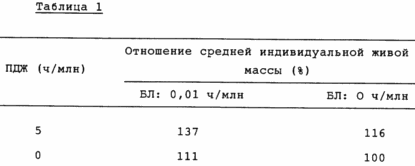
Example 2
The effect of growth stimulation achieved by spraying on radish
The PDJ was dispersed in a mixed liquid of xylene, isophorone and polyoxyethylene alkylphenyl ether (Volume ratio = 60: 20: 20) to obtain a 20% (w / v) PDJ emulsion. BL was dissolved in ethanol to produce a BL solution having a concentration of 100 ppm. Using the PDJ emulsion and the BL solution, aqueous test solutions containing active ingredients having the concentrations given in Table 2 were prepared.
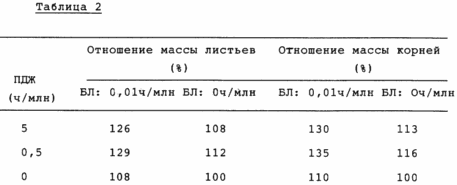
Radish (cultivar: Akamaru-comet) was cultivated in a conventional way in an open field, at the stage of initiation of root system proliferation, aqueous test solutions were sprayed onto the soil in an amount of 10 liters per 100 m 2 . Sixteen days after the spraying, 15 well-grown plants were harvested. The mass of leaves and roots was measured and the ratio in% of these masses to those weights measured on control plants cultivated without the use of active ingredients was calculated. The results are shown in Table 2. As can be seen from Table 2, the synergistic effects of growth stimulation are demonstrated by the combined use of PDJ and BL.
Example 3
The effect of growth stimulation achieved by cultivation of planting potatoes
Test solutions containing the PDJ and BL in the concentrations shown in Table 3 were prepared using a mixed liquid consisting of ethanol and water (volume ratio = 70/30), and the Mayqueen planting potatoes were immediately dipped into the test solutions.
Fifteen thus treated planting potatoes were planted in each zone of the field one day after the dipping treatment and cultured in a conventional manner. Eighty days after planting, well-grown plants from each zone were taken and weighed. From the average weight of the potato, the ratio in% of this mass to the mass measured on the control potatoes cultivated without treatment with the active ingredient was calculated. The results are shown in Table 3. As can be seen from Table 3, the synergistic effects of growth stimulation are demonstrated in the combined use of PDJ and BL.
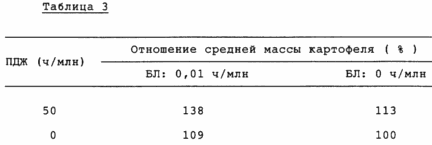
Example 4
The effect of stimulation of hypertrophic growth on tomatoes
By the same methods as used in Example 2, test solutions containing either a PDJ or BL, or both in the concentrations shown in Table 4 were obtained. Tomatoes (variety: Momotarou) were cultured in a conventional manner inside a vinyl greenhouse in winter. Test solutions were applied three times, each time in an amount of 100 ml per plant. The first application was carried out at the development stage, when the third fruit brush began to develop strongly and the fourth fruit brush blossomed, the second application was carried out 20 days after the first application, and the third application was carried out one week before the third fruit brush was cleaned, that is 20 days after Second application.
All the fruits of the fourth fruit brush and the fourth fruit brush were collected in a conventional way and the fruits from each zone (10 plants per zone) were weighed and the ratio in% of this average mass to the average mass measured on control tomatoes cultured without the use of test solutions was calculated. The results are shown in Table 4. As can be seen from Table 4, the synergistic effects of fetal growth stimulation are demonstrated by the combined use of PDJ with BL.
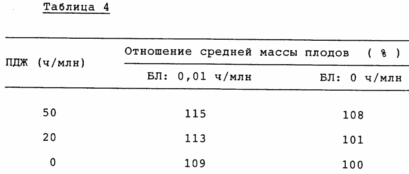
Example 5
The effect of preventing low temperature damage
In the same manner as used in Example 2, test solutions containing either a PDJ or DB, or both in the concentrations shown in Table 5 were obtained. Benjamin trees having an average height of 30 to 40 cm and 150 to 200 leaves were cultured By conventional methods in the growing pots inside the greenhouse. Test solutions were sprayed onto each tree in an amount of 20 ml per tree. Treated trees were left outdoors in conditions of natural low temperature for a period of one month from the day after the use of the solution, and this month began at the end of November and ended at the end of December. Counted the number of leaves fallen off due to low temperature damage. The degree of defoliation determined by the following equation was calculated.
Degree of defoliation (%) = (number of fallen leaves / number of leaves before placing in open air) x 100.
The results are shown in Table 5. As can be seen from Table 5, the increased effects of preventing low-temperature damage are demonstrated in the combined use of PDJ with BL.
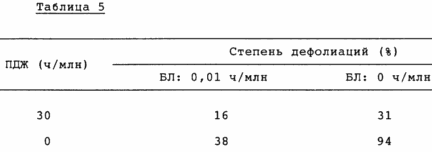
Example 6
The effect of growth stimulation achieved by the treatment of rice-paddy seeds
Rice-paddy seeds (variety: Nippon-Bare) were immersed in cold water, which was stored at 15 ° C for one day. In the same manner as used in Example 2, test solutions containing either a PDJ or BL or both in the concentrations shown in Table 6 were obtained. The seeds were then immersed in each of the test solutions for 24 hours and then immersed in water for 3 hours. Then, the treated seeds were then sown in vegetation vessels, each having a diameter of 7 cm, and cultivated at 20-21 ° C under constant illumination conditions at 15,000 lux (lumen / m 2 ) in an air-conditioned room. When 1/4 (i.e. 25%) of the rice-paddy control plants in the cultivation zone of the untreated plants reached the third leaf stage, the growth condition (plant height and root weight of the rice) of the rice cultures of all cultivation zones was evaluated. The ratio in% of the height of the plant and the live weight of these grown rice plants was calculated to the height of the plant and the live weight of the control rice plants cultivated in the cultivation zone of the untreated plants. The results are shown in Table 6.
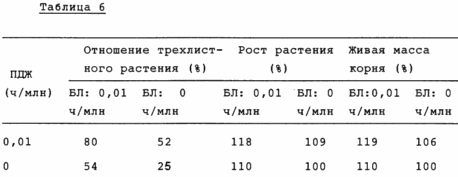
Example 7
The effects of growth stimulation achieved by the treatment of maize and soybean seeds with cultured
In the same manner as in Example 1, test solutions containing either PDJ or BL, or both in the concentrations shown in Table 7, were obtained. Seeds (culture soybean: Honey bantam, soybean culture: mug-bean) were dipped instantly into each From the test solutions and immediately then dried in air. The dried seeds were sown at the generally accepted stage of cultivation in the field. Twenty-five days after sowing, the live weight of the plants and the ratio in% of this live weight to the live weight of the control plants cultivated in the zone seeded with untreated seeds were measured. As can be seen from Table 7, a high growth stimulation effect can be achieved by the combined use of two active ingredients.
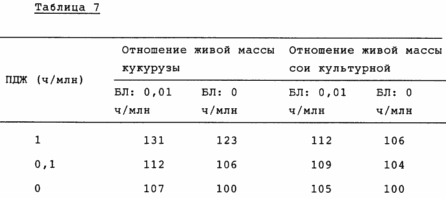
Example 8
The effect of increasing the yield achieved by sprinkling on rice-paddy seedlings
In the same manner as in Example 2, test solutions containing either a PDJ or BL, or both in the concentrations shown in Table 8 were prepared. The test solutions were sprayed onto 150 grams of rice-paddy sprouts (variety: Chiyoni-shiki) On an area of 25 cm x 50 cm. Two days after sprinkling, the seedlings were planted in a rice field and cultivated in a generally accepted manner. As can be seen from Table 8, the yield of unpeeled rice is increased by treating only the PDJ or BL, but it is significantly increased by treatment with a combination of PDJ and BL.
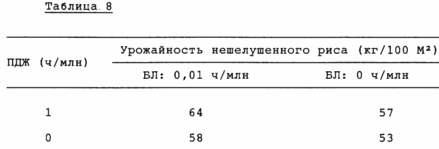
Example 9
Effect of increasing the speed of fruit peach
In the same manner as used in Example 2, test solutions containing the active ingredients at the concentrations shown in Table 9 were prepared. Peach plants (Hokuhou) were cultured in a conventional manner on the field. At the beginning of flowering, each test solution was sprayed in an amount of 300 liters per 1000 m2, and after one month the rate of fruit initiation was estimated (that is, the ratio of the number of fruits to the number of colors when sprayed). As can be seen from Table 9, combined use of PDJ with BL shows an increased rate of fruit setting.

Example 10
Preparation of propyldihydrozhasmonate (PDJ)
A four-necked 200 ml flask equipped with a distillation column was charged with 67.8 g of methyldihydrozhasmonate, 72.0 g of n-propanol and 1.7 g of a 28% solution of sodium methoxide in methanol.
The contents are maintained at a temperature of 110 ° C. under normal pressure for 7 hours and an exchange reaction is carried out by distilling the resulting methanol through the top of the column.
After completion of the reaction, n-propanol was distilled off and the reaction product was washed with dilute hydrochloric acid and then with a saturated solution of sodium hydrogencarbonate.
The washed product is then distilled under a reduced pressure of 2 mm Hg. To obtain the desired product with a purity of 98% (by gas chromatography).
Yield 70%; The boiling point is 153-157 ° C.
Spectral analysis of propyldihydrozhasmonate:
1H-NMR (500 MHz CDCl3 / TMC) ![]() (Ppm): 0.88 (t, CH3, 3H), 1.26 (t, CH3, 3H), 1.26-2.82 (m, 18H), 4.08 (t, CH2, 2H)
(Ppm): 0.88 (t, CH3, 3H), 1.26 (t, CH3, 3H), 1.26-2.82 (m, 18H), 4.08 (t, CH2, 2H)
IR (neat, cm- 1 ), 1738 (C = 0), 1170 (CC-O), 1461 (cyclic CH)
Mass (EI, 70 eV), 254 (M + ), 211, 195, 184, 153, 96, 83, 43
INDUSTRIAL APPLICABILITY
The plant growth promoter of the present invention exhibits a growth stimulation effect for a wide variety of plants, which includes root crops, potatoes and taro, cereals, fruit and vegetable crops, leafy vegetables, fruit trees, tree plants, flowering plants and industrial plants. As specific examples of plants to which the plant growth promoter of the present invention is applied, mention may be made of root crops, for example radish, carrots, onions, table beet, turnips and edible burdock; Potatoes and taro, for example potatoes, sweet potatoes, taro and tapioca; Cereals such as rice, barley, wheat, oats, Italian millet, Japanese millet, millet cultivation, buckwheat and corn; Fruit vegetable crops, for example cucumbers, sweet pepper, pumpkin, watermelon, oriental marinated melon, melon, musk melon, okra, strawberry and tomatoes; Leguminous crops, for example, cracked bean varieties used for growing on a scapula, fodder beans, peas, soybean, peanuts and beans are angular; Leafy vegetable crops, for example, Chinese cabbage, cabbage, horticultural cabbage, leek, cabbage, parsley, Japanese hornwort triturated, celery, small dwarf carrot, spinach, lettuce, rapeseed and mustard; Fruit trees, such as grapevine, pear tree, apple tree, peach tree, persimmon and mandarin tree; Woody plants, for example Japanese cedar, cypress, pine and thuju; Flowering plants, for example, a lily, a tulip, a gladiolus, a carnation and a rose; And industrial crops, for example, cotton, hemp, sugar cane, lawn grass and hamstring. Plants for which a plant growth promoter can be used are not limited to these plants. For example, the plant growth promoter of the present invention can be used for herbs and trees growing or planted in a desert or abandoned land.
Parts of the plant systems showing the desired growth stimulation effects of the growth promoter of the present invention vary with the particular plant species. For example, the desired growth stimulation response develops on leaves, stems, roots, tubers, rhizomes, fruits and flower buds. More specifically, growth-stimulating effects are manifested on leaves, stems, roots, tubers, rhizomes and fruits. There is a stimulation of differentiation of flower buds, which leads to an increase in the speed of development and an increase in the number of colors. With regard to fruits, the speed of tying, the weight, the degree of sugar content and the density of fruit coloring are increased.
CLAIM
1. A plant growth promoter comprising, as active ingredients (i) jasmonic acid or jasmonate represented by the following formula (1) 
Where R 1 is a pentyl or pentenyl group;
R 1 is hydrogen or an alkyl group, and (ii) a brassinosteroid represented by the following formula (2): 
And a liquid carrier wherein the weight ratio of the brassinosteroid of formula (2) to jasmonic acid or jasmonate of formula (1) (i): (ii) is in the range 1: 1 to 1: 5000, and the content of component (i): (ii) is 0.01 to 500 ppm and 0.001 to 1 ppm, respectively, based on the total weight of the stimulant composition.
2. Plant growth promoter according to claim 1, wherein R 1 in formula (1) is a pentyl group or a 2-pentenyl group.
3. Plant growth promoter according to any one of claims 1 and 2, wherein R 2 in formula (1) is an alkyl group having 1 to 10 carbon atoms.
4. Plant growth promoter according to any one of claims 1 to 3, wherein the jasmonate of formula (1) is n-propyl dihydrojasmonate.
print version
Date of publication 05.03.2007gg




Comments
When commenting on, remember that the content and tone of your message can hurt the feelings of real people, show respect and tolerance to your interlocutors even if you do not share their opinion, your behavior in the conditions of freedom of expression and anonymity provided by the Internet, changes Not only virtual, but also the real world. All comments are hidden from the index, spam is controlled.